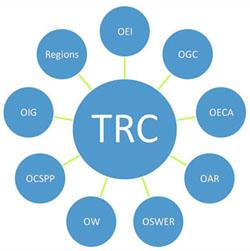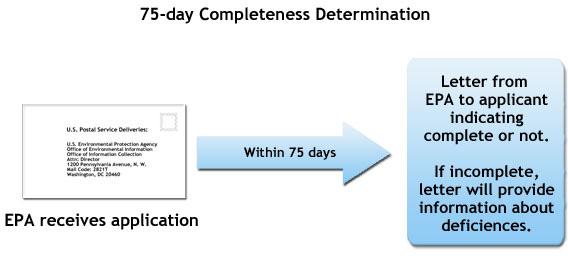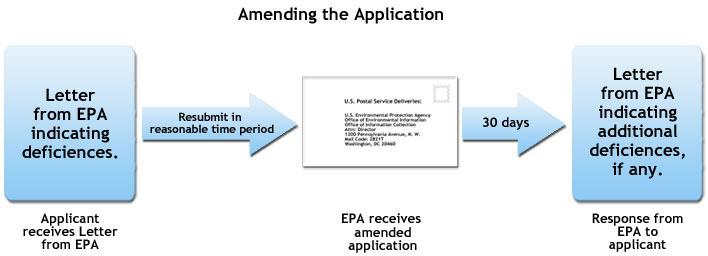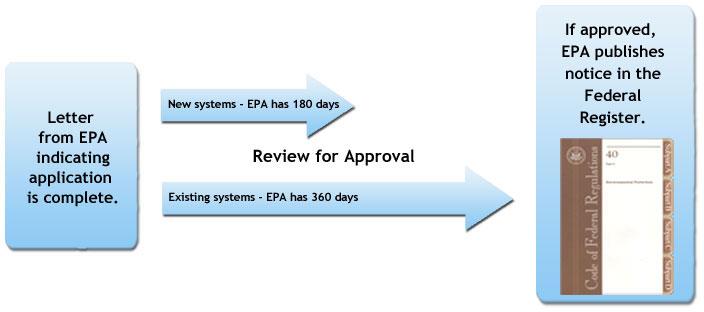Lesson 4: Technical Review Committee (TRC)

Applications formally submitted to the EPA are reviewed by an Agency-wide TRC, which includes representatives from the following offices:
- Office of Environmental Information (OEI)
- Office of General Council (OGC)
- Office of Enforcement and Compliance Assurance (OECA)
- Office of Air and Radiation (OAR)
- Office of Solid Waste and Emergency Response (OSWER)
- Office of Water (OW)
- Office of Chemical Safety and Pollution Prevention (OCSPP)
- Office of the Inspector General (OIG)
- Each of the 10 EPA Regions
The TRC conducts both the completeness reviews and the approval reviews. The approval reviews conclude with a recommendation to the EPA Administrator, or their designee, to either approve or deny the application for program revision or modification.
Checking for Completeness
EPA first reviews an application for completeness, as described in § 3.1000(b)(3)(i)of CROMERR. Within 75 calendar days of receiving an application, EPA will send a letter to the applicant specifying whether or not the application is complete. For incomplete applications, the letter includes information on the application deficiencies.
States, tribes, and local governments may amend an application after EPA has determined the application package to be incomplete. For EPA to review an amended application, it must be resubmitted within "a reasonable period of time."
If application deficiencies are not remedied within a "reasonable period of time," EPA may act to approve or disapprove an incomplete application.
 A diagram of the 75-day Completeness Determination: EPA receives application and within 75 days there will be a letter from EPA to the applicant indicating completeness.
A diagram of the 75-day Completeness Determination: EPA receives application and within 75 days there will be a letter from EPA to the applicant indicating completeness.- CROMERR § 3.1000(b)(3)(i) (PDF) (43 pp, 520 K) You will need Adobe Reader to view some of the files on this page. See EPA’s About PDF page to learn more.
Amending the Application
Applicants who receive a notice of deficiencies and then correct the issues in the application may resubmit the application. EPA then has 30 calendar days from time of receipt to respond with a new complete or incomplete determination.
 A diagram of the Amending the Application Process: A letter from EPA indicating deficiencies is sent to the applicant, they then can resubmit the amended application in a reasonable time period. EPA has 30 days from receiving the amended application to send a letter response indicating any additional deficiencies.
A diagram of the Amending the Application Process: A letter from EPA indicating deficiencies is sent to the applicant, they then can resubmit the amended application in a reasonable time period. EPA has 30 days from receiving the amended application to send a letter response indicating any additional deficiencies.- CROMERR § 3.1000(b)(3)(i) (PDF) (43 pp, 520 K) You will need Adobe Reader to view some of the files on this page. See EPA’s About PDF page to learn more.
Approval Review
Once EPA determines that an application is complete, the next step is to determine whether the application is approvable by reviewing it for compliance with CROMERR requirements spelled out in § 3.2000 of CROMERR.
For new systems, the Agency has 180 days from notification of completeness to conduct the approval review. If EPA does not act on a program revision or modification by the end of the 180-day approval review period, then that revision or modification is automatically approved.
For existing systems, the Agency has 360 days to evaluate the application for approval, and, again, failure to act before the review period ends results in automatic approval.
CROMERR does not require EPA to take the same action on all the program revisions or modifications in a consolidated application. EPA may approve some of the program revisions or modifications in the consolidated application, and disapprove others, as provided under § 3.1000(c)(2).
The approval generally becomes effective as of the date that EPA publishes a notice of the approval in the Federal Register.
 A diagram showing the Review for Approval Process. A letter from EPA indicates the application is complete. Then EPA has 180 days (for a new system) or 360 days (for an existing system) to publish a notice in the Federal Register.
A diagram showing the Review for Approval Process. A letter from EPA indicates the application is complete. Then EPA has 180 days (for a new system) or 360 days (for an existing system) to publish a notice in the Federal Register.- CROMERR § 3.1000(c) (PDF) (43 pp, 520 K) You will need Adobe Reader to view some of the files on this page. See EPA’s About PDF page to learn more.
- CROMERR § 3.1000(c)(4)(ii) (PDF) (43 pp, 520 K)
- CROMERR § 3.1000(d) (PDF) (43 pp, 520 K)
- Sample EPA Notice from the Federal Register (PDF) (1 pg, 173 K)
Public Hearing Provision for Public Water System Programs
 Applications for authorized public water system programs under Part 142 must provide the opportunity for a public hearing. Once EPA makes a preliminary determination to approve or deny the request for program revision or modification, EPA will publish a notice in the Federal Register. Requests for hearings must be submitted to EPA within 30 days after publication.
Applications for authorized public water system programs under Part 142 must provide the opportunity for a public hearing. Once EPA makes a preliminary determination to approve or deny the request for program revision or modification, EPA will publish a notice in the Federal Register. Requests for hearings must be submitted to EPA within 30 days after publication.
If a hearing is requested, EPA will announce the hearing in the Federal Register at least 15 days before the scheduled date. Based upon the results of the hearing, EPA will issue an order, either affirming or rescinding its preliminary determination, and will publish a Final Notice in the Federal Register.
If the order is to approve the program revision or modification, EPA's approval is effective upon publication of the Final Notice. However, if no hearing is requested, EPA's preliminary determination will be effective 30 days after the first notice was published.
- CROMERR § 3.1000(f) (PDF) (43 pp, 520 K) You will need Adobe Reader to view some of the files on this page. See EPA’s About PDF page to learn more.
Special Notes Regarding the Application Process
Remember that in consolidated applications, EPA is not required to take the same action on all revisions and modifications. For more information on this topic, reference § 3.1000(c)(2) of CROMERR.
Also note that authorized programs with approved program modifications or revisions to incorporate electronic reporting must apprise EPA of any changes (including laws, policies, and systems) that may affect program compliance with CROMERR requirements. For further information on this topic, reference § 3.1000(a)(4) of the CROMERR.
- CROMERR § 3.1000(c)(2) (PDF) (43 pp, 520 K)
- CROMERR § 3.1000(a)(4) (PDF) (43 pp, 520 K)
You will need Adobe Reader to view some of the files on this page. See EPA’s About PDF page to learn more.
